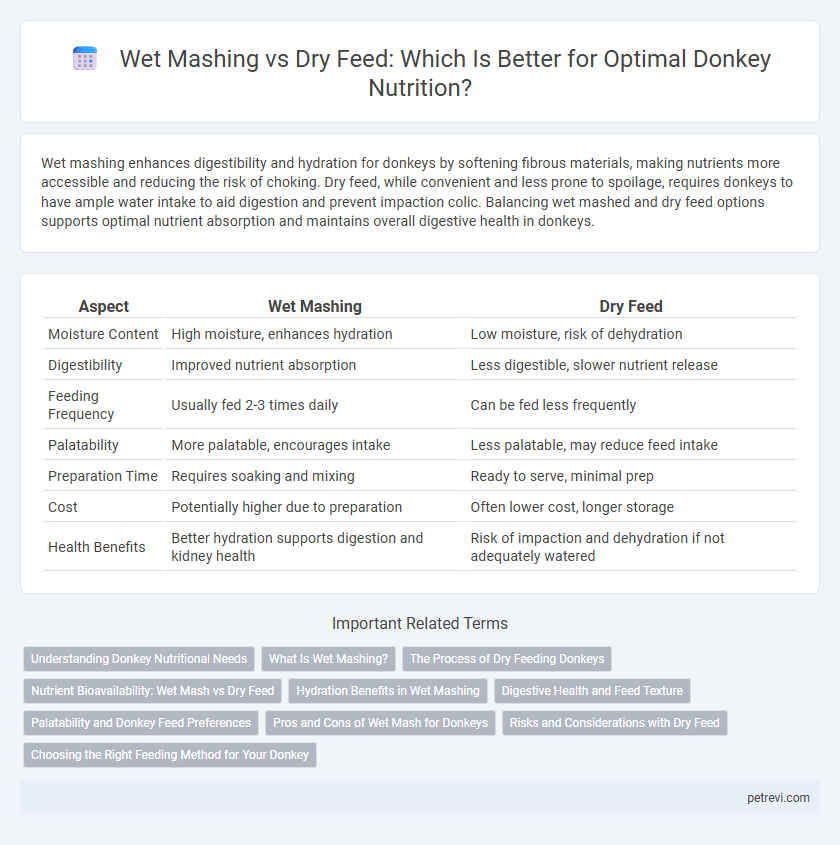Wet mashing enhances digestibility and hydration for donkeys by softening fibrous materials, making nutrients more accessible and reducing the risk of choking. Dry feed, while convenient and less prone to spoilage, requires donkeys to have ample water intake to aid digestion and prevent impaction colic. Balancing wet mashed and dry feed options supports optimal nutrient absorption and maintains overall digestive health in donkeys.
Table of Comparison
| Aspect | Wet Mashing | Dry Feed |
|---|---|---|
| Moisture Content | High moisture, enhances hydration | Low moisture, risk of dehydration |
| Digestibility | Improved nutrient absorption | Less digestible, slower nutrient release |
| Feeding Frequency | Usually fed 2-3 times daily | Can be fed less frequently |
| Palatability | More palatable, encourages intake | Less palatable, may reduce feed intake |
| Preparation Time | Requires soaking and mixing | Ready to serve, minimal prep |
| Cost | Potentially higher due to preparation | Often lower cost, longer storage |
| Health Benefits | Better hydration supports digestion and kidney health | Risk of impaction and dehydration if not adequately watered |
Understanding Donkey Nutritional Needs
Donkeys require a high-fiber diet primarily consisting of roughage to maintain optimal digestive health, making wet mashing less suitable compared to dry feed options like hay and straw. Dry feed mimics their natural grazing habits, promoting proper gut motility and preventing digestive disorders such as colic and laminitis. Ensuring adequate intake of dry, fibrous materials aligns with their evolutionary adaptations and supports their unique metabolic needs.
What Is Wet Mashing?
Wet mashing is a feeding method where dry feed ingredients like grains and bran are soaked in water to create a moist, easily digestible mixture for donkeys. This technique enhances nutrient absorption and reduces the risk of choke and colic by softening fibrous components. Proper wet mashing supports digestive health and improves feed intake efficiency in donkey nutrition.
The Process of Dry Feeding Donkeys
Dry feeding donkeys involves providing them with pre-measured, nutrient-dense feed without the addition of water, which helps maintain stable nutrient levels and reduces the risk of digestive issues such as colic. This method simplifies feeding routines, allowing for controlled intake of fiber, protein, vitamins, and minerals essential for maintaining optimal health and energy balance. Proper dry feeding requires selecting high-quality hay or pelletized feed tailored to donkeys' specific digestive systems and ensuring consistent access to clean water for hydration.
Nutrient Bioavailability: Wet Mash vs Dry Feed
Wet mashing enhances nutrient bioavailability in donkeys by increasing moisture content, which facilitates easier digestion and absorption of nutrients compared to dry feed. The soft texture of wet mash promotes better microbial activity in the donkey's gut, leading to improved breakdown of fibers and starches essential for energy. Conversely, dry feed often results in slower nutrient release and reduced bioavailability, potentially limiting optimal nutrient uptake and overall health.
Hydration Benefits in Wet Mashing
Wet mashing enhances donkey nutrition by improving hydration levels, crucial for digestive efficiency and overall health. The moisture content in wet mashing promotes better feed intake and nutrient absorption compared to dry feed, reducing dehydration risks. Optimal hydration through wet mashing supports metabolic functions and prevents colic, a common digestive disorder in donkeys.
Digestive Health and Feed Texture
Wet mashing enhances donkey digestion by softening fibrous feed, promoting efficient nutrient absorption and preventing impaction colic. Dry feed maintains natural chewing behavior, stimulating saliva production that buffers stomach acidity and supports microbial balance in the hindgut. Selecting the appropriate feed texture optimizes digestive health by balancing moisture content and mechanical processing to meet donkeys' unique gastrointestinal needs.
Palatability and Donkey Feed Preferences
Donkeys exhibit a marked preference for wet mashing over dry feed due to enhanced palatability, which stimulates increased voluntary intake and better hydration. Wet mashing softens fibrous components, improving digestibility and mimicking natural foraging moisture content preferred by donkeys. Incorporating wet mash in donkey diets can effectively optimize feed acceptance and nutritional uptake, supporting overall health and performance.
Pros and Cons of Wet Mash for Donkeys
Wet mashing in donkey nutrition offers benefits such as improved hydration and easier digestion, particularly for older or dental-impaired donkeys, as the moisture softens the feed and aids nutrient absorption. However, wet mash can spoil quickly if not consumed promptly, increasing the risk of mold growth and potential digestive upset. Its preparation demands more time and resources compared to dry feed, which is often more convenient and has a longer shelf life but may not provide the same digestive benefits.
Risks and Considerations with Dry Feed
Dry feed for donkeys poses risks such as choking hazards and digestive disturbances due to insufficient water intake, potentially leading to colic or impaction. Proper hydration and careful portioning must be maintained to mitigate these concerns and ensure optimal nutrient absorption. Monitoring feed quality is essential, as moldy or dusty dry feed can exacerbate respiratory issues and compromise overall health.
Choosing the Right Feeding Method for Your Donkey
Wet mashing enhances nutrient absorption and hydration in donkeys by softening fibrous feeds, making it ideal for older or dental-impaired animals. Dry feed maintains natural chewing behaviors and dental health, supporting optimal digestion in healthy donkeys with no feeding difficulties. Selecting the proper method depends on your donkey's age, dental condition, and hydration needs to ensure balanced nutrition and overall well-being.
Wet Mashing vs Dry Feed for Donkey Nutrition Infographic

 petrevi.com
petrevi.com